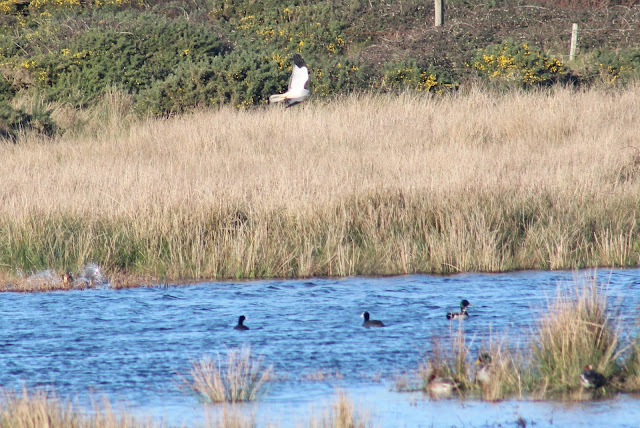A three harrier day at Marloes was reward for enduring the bitter wind. First up was a juvenile Marsh Harrier seen from the car park that had a look around the eastern end of the mere before settling down in the largest grassy island in the marsh to the north-east of the Britton hide. The golden crown could be seen glinting in the sun as the wind ruffled it. It would not be visible from the hide or by the birds on the water.
About 30 minutes later, and seen from the barbed wire gate, a juvenile ringtail Hen Harrier, definitely not a Pallid, flew in from the west and did a single meandering low, slow lap before disapearing back towards the west. After another 30 minutes, and this time seen from inside the hide and with the camera out of the bag, a male Hen Harrier flew in from the west with much commotion amongst the ducks and crows. One crow persisted in chasing the harrier up the hill and around the fields south or Trehill farm, which caused the harrier to twist and turn giving good views and showed a mantle with a little brownish tint. It too disappeared off to the west.
A little later the juvenile Marsh Harrier reappeared, apparently having taken off from the grassy island and put up lost of duck and Snipe, but quickly settled down again in long grass and was lost from sight. This time it chose the marshy grass on the north side of the mere at the end of the lane to Trehill farm.
Also on the mere were about 450 Herring Gulls with a single Lesser Black Back. One of the juveniles was apparently frozen on top of the ice, remaining standing on the same spot for at least an hour, and was left standing there when the flock departed to feed on the fields below the farm. Five Tufted Ducks, at least 39 Shoveler, at least four Gadwall plus a couple of dozen Wigeon and Teal as well as three Little Grebe, a few Coot and Moorhen made up the rest of the water birds. There were no geese today. About 120 Lapwings and 500 Starlings were in a mixed feeding flock with corvids in the fields west of Trehill farm, which was disturbed by an unseen predator.
